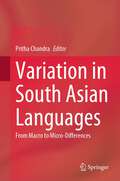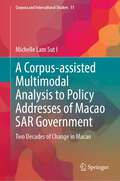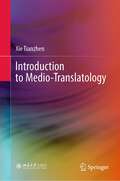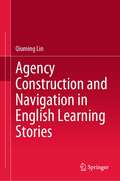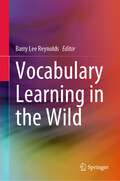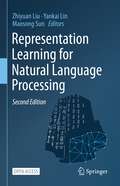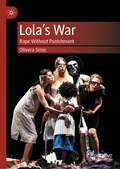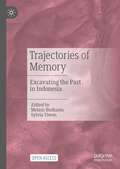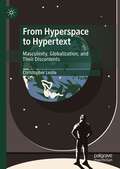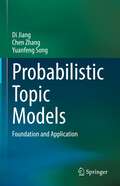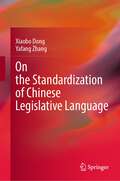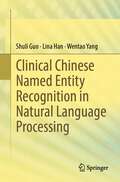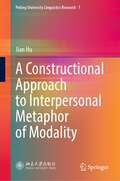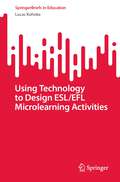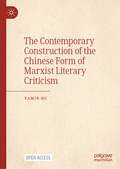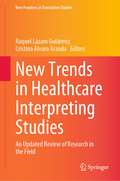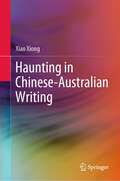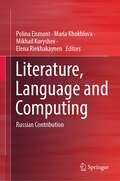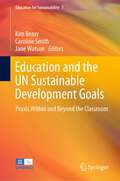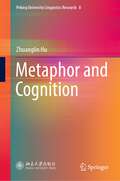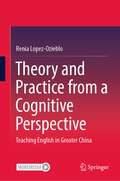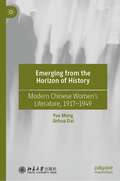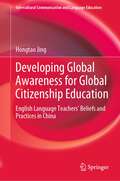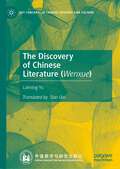- Table View
- List View
Variation in South Asian Languages: From Macro to Micro-Differences
by Pritha ChandraThe book addresses some raging questions in linguistics today: What kind of variation do typologically related languages display? Do we expect to find the same variation in genealogically unrelated languages spoken in the same area? What makes dialects different? The current book answers these questions using data from languages spoken in the Indian subcontinent—an area known for its linguistic richness and diversity. Each chapter in the book presents a wealth of data collected through extensive fieldwork or controlled experimental setups. The chapters examine macro-variation in relative clauses, word order and negation found among Austro-Asiatic, Dravidian, Indo-Aryan and Tibeto-Burman languages. It also investigates meso-level variation among related Eastern Indo-Aryan languages and intra-language and dialectal changes. It encourages scholars to probe deep into the mechanisms that underlie the immense intra- and inter-language variation in the area. It serves as a resource book for postgraduate and research scholars of linguistic typology, theoretical syntax, sociolinguistics, historical linguistics and for scholars interested in South Asian languages.
A Corpus-assisted Multimodal Analysis to Policy Addresses of Macao SAR Government: Two Decades of Change in Macao (Corpora and Intercultural Studies #11)
by Michelle Lam Sut IThis book introduces an integrated framework with corpus-assisted approach to deal with large set of data of discourse with multimodal factors to investigate how policy addresses (the government reports of Macao SAR) as a discourse type function in the social changes of Macao SAR through discussing the social factors to the production and consumption of policy addresses. The book explores research models or methodology in dealing with the contemporary topics in translation studies with a detailed presentation of the application of an analytical framework which marries corpus-assisted analysis, discourse analysis from socio-cultural perspective and multimodality with translation studies. Withal, the book is with the chapters to review the development of the social approach to discourse analysis and to introduce the stories of Macao with the summary of the development of this special region, in academic field, political and cultural fields.
Introduction to Medio-Translatology
by Xie TianzhenThis book offers a comprehensive introduction to medio-translatology, including its historical and literary setting, its core concept, and its practice and theory. Medio-translatology, inspired by scholarship in comparative literature and the “cultural turn” in Western translation studies, has tackled many issues which previously went unnoticed or were ignored in traditional translation studies in China; it falls within the scope of literary studies and cultural studies, extending beyond the confines of language and treating literary translations and translating as historical facts.Emerging from comparative literature, medio-translatology looks at literary translation from a new and broader perspective, and explains, with illustrative and compelling examples, that literary translation is “an act of creative treason.” The originality of this approach is also evident in its distinguishing between the history of translated literature and the history of literary translation, as well as in its addressing the nature and status of translated literature.The Chinese edition of this book, being the first of its kind and well received in China, has been hailed as a milestone in exploring translation studies in the context of comparative literature in Chinese academia, and it introduces to students and researchers alike a wide range of new thoughts and ideas.
Agency Construction and Navigation in English Learning Stories
by Qiuming LinThis book presents a longitudinal research which covers a linguistic approach to understand and observe language learner agency. It makes connections between agency in discourse analyses and agency in applied linguistics by examining how learner agency is manifested in autobiographic oral narratives and influenced by contextual factors. This book also demonstrates that agency is not a fixed entity that English learners possess, but a dynamic construct constantly negotiated by the learners with the social world. It is the result of their identity positioning and repositioning within a complex and ever-changing context. Learner identities, either actual or imagined, are significantly correlated with their investment in English and their English learning process.This book sheds new light on teaching English as a foreign language and gives inspirations for enhancing English learners’ agency in contemporary context of China. As learner agency should be treated in a dynamic and process view, a low level of agency manifested in a particular period or in a certain context may not necessarily persist in later periods or extend to other contexts. Provided with supportive contextual conditions and taking on positive and powerful identities, language learners are well on the course for higher levels of agency.
Vocabulary Learning in the Wild
by Barry Lee ReynoldsThis book provides a timely and valuable resource to explore second language vocabulary learning outside the formal language learning classroom. Rapidly evolving technology and the increasing impact of the global village have resulted in dramatic changes to and increased occasions for second language vocabulary learning. This book offers new and valuable insights into the radically different opportunities both the physical and digital wild provide for language learners to increase their vocabulary knowledge. Practical advice is also given on how second language teachers can integrate vocabulary learning in the wild into their formal classroom instruction. This collection of cutting-edge studies by international experts working within the fields of second language teaching and learning, second language acquisition, applied linguistics, informal language learning, and technology enhanced learning offers an essential resource for language teachers and researchers.The internet is a powerful source of incidental language learning, but this is only part of language learning in the wild. This excellent book shows the range of opportunities available for learning another language outside the classroom in this much neglected research area. --Paul Nation, Emeritus Professor, Victoria University of Wellington
Representation Learning for Natural Language Processing
by Zhiyuan Liu Yankai Lin Maosong SunThis book provides an overview of the recent advances in representation learning theory, algorithms, and applications for natural language processing (NLP), ranging from word embeddings to pre-trained language models. It is divided into four parts. Part I presents the representation learning techniques for multiple language entries, including words, sentences and documents, as well as pre-training techniques. Part II then introduces the related representation techniques to NLP, including graphs, cross-modal entries, and robustness. Part III then introduces the representation techniques for the knowledge that are closely related to NLP, including entity-based world knowledge, sememe-based linguistic knowledge, legal domain knowledge and biomedical domain knowledge. Lastly, Part IV discusses the remaining challenges and future research directions.The theories and algorithms of representation learning presented can also benefit other related domains such as machine learning, social network analysis, semantic Web, information retrieval, data mining and computational biology. This book is intended for advanced undergraduate and graduate students, post-doctoral fellows, researchers, lecturers, and industrial engineers, as well as anyone interested in representation learning and natural language processing.As compared to the first edition, the second edition (1) provides a more detailed introduction to representation learning in Chapter 1; (2) adds four new chapters to introduce pre-trained language models, robust representation learning, legal knowledge representation learning and biomedical knowledge representation learning; (3) updates recent advances in representation learning in all chapters; and (4) corrects some errors in the first edition. The new contents will be approximately 50%+ compared to the first edition. This is an open access book.
Lola’s War: Rape Without Punishment
by Olivera SimicThis longitudinal study is based on the story of Lola, who was gang raped during the war in Bosnia and Herzegovina in 1992. At the time, she was in a detention camp with her young children. Only one of Lola’s several perpetrators was convicted but his sentence of six years of imprisonment has never been actioned by the Bosnian judiciary. Lola’s rapist is still free and she lives in continual fear that he will retaliate against her and her children for her role in his trial.
Trajectories of Memory: Excavating the Past in Indonesia
by Melani Budianta Sylvia TiwonThis book is a collection of essays in Indonesian history and archaeology dealing with different and multiple trajectories, along four broad themes. The first part of the book covers competing or evolving representations of events, customs or traditions, and historical personae in Indonesian official and popular expression, as they are shaped by economic, political, and cultural forces. The second part deals with memories of war and peace, examining transnational conflict and collaboration, the role of political elites and state projects dealing with the aftermath of military aggression, while also focusing on the impact and responses of civilians. The third part focuses on how state and civil societies frame historical figures, in ways that transcend the dichotomy of heroes and victims. The fourth part of the book looks at the way Indonesian museums and museology serve as sites where new kinds of memory work occur, in a post-1998 era.The book is designed with the aim of clearing a space for a plurality of memory works. Discussions in this volume extend from Loloda island in Eastern Indonesia, to Sabang island at the north westernmost end of the archipelago, and to the cosmopolitan centers. Temporally, it covers the colonial, the post-independence and contemporary eras. By juxtaposing diverse works, the book offers a new vista of multiple trajectories of memory being traced out in and about Indonesia.This is an open access book.
From Hyperspace to Hypertext: Masculinity, Globalization, and Their Discontents
by Christopher LeslieThis book illuminates how science fiction studies can support diversity, equity, and inclusion in science and engineering. Shortly before science fiction got its name, a new paradigm connected whiteness and masculinity to the advancement of civilization. In order to show how science fiction authors supported the social construction of these gender and racial norms – and also challenged them – this study analyzes the impact of three major editors and the authors in their orbits: Hugo Gernsback; John W. Campbell, Jr.; and Judith Merril. Supported by a fresh look at archival sources and the author’s experience teaching Science and Technology Studies at universities on three continents, this study demonstrates the interconnections among discourses of imperialism, masculinity, and innovation. Readers gain insights into fighting prejudice, the importance of the community of authors and readers, and ideas about how to challenge racism, sexism, and xenophobia in new creative work. This stimulating book demonstrates how education in science, technology, engineering, and mathematics (STEM) can be enhanced by adding the liberal arts, such as historical and literary studies, to create STEAM.
Probabilistic Topic Models: Foundation and Application
by Di Jiang Chen Zhang Yuanfeng SongThis book introduces readers to the theoretical foundation and application of topic models. It provides readers with efficient means to learn about the technical principles underlying topic models. More concretely, it covers topics such as fundamental concepts, topic model structures, approximate inference algorithms, and a range of methods used to create high-quality topic models. In addition, this book illustrates the applications of topic models applied in real-world scenarios. Readers will be instructed on the means to select and apply suitable models for specific real-world tasks, providing this book with greater use for the industry. Finally, the book presents a catalog of the most important topic models from the literature over the past decades, which can be referenced and indexed by researchers and engineers in related fields. We hope this book can bridge the gap between academic research and industrial application and help topic models play an increasingly effective role in both academia and industry. This book offers a valuable reference guide for senior undergraduate students, graduate students, and researchers, covering the latest advances in topic models, and for industrial practitioners, sharing state-of-the-art solutions for topic-related applications. The book can also serve as a reference for job seekers preparing for interviews.
On the Standardization of Chinese Legislative Language
by Xiaobo Dong Yafang ZhangBy integrating different research angles and methods of philosophy of law, sociology of law, applied linguistics, and legal translation, this book presents a groundbreaking approach to the non-standardization phenomenon in Chinese legislative language, unveils the underlying causes and adverse effects thereof, and provides potential principles, strategies, and methods to be followed in the standardization of Chinese legislative language. Divided into three parts, this book firstly talks about the fuzziness of language, addressing both the active and negative influences thereof on the legislation; secondly approaches the non-standardization phenomenon in Chinese legislative language from the perspective of philosophy of law; and thirdly offers a comprehensive studies on the standardization of Chinese legislative language, offering possible solutions to address the above-mentioned problems and promote the standardized development of law making. This book facilitates the legal practitioners, jurists, law students, legal translators as well as the non-experts to get a better understanding of the mechanism and process of legislation and improve their skills and capacities in apprehending and translating Chinese laws and regulations.
Clinical Chinese Named Entity Recognition in Natural Language Processing
by Shuli Guo Lina Han Wentao YangThis book introduces how to enhance the context capture ability of the model, improve the position information perception ability of the pretrained models, and identify and denoise the unlabeled entities. The Chinese medical named entity recognition is an important branch of the intelligent medicine, which is beneficial to mine the information hidden in medical texts and provide the medical entity information for clinical medical decision-making and medical classification. Researchers, engineers and post-graduate students in the fields of medicine management and software engineering.
A Constructional Approach to Interpersonal Metaphor of Modality (Peking University Linguistics Research #7)
by Jian HuThis book is a current and comprehensive study that incorporates constructional frameworks to inquire grammatical metaphor of modality (MM) for more adequate description and explanation of grammatical metaphor. It conducts semantic analysis of MM via a refined cognitive model and investigation of its lexicogrammatical forms from corpus-based constructional approach. The result is a reliable and systemic record of MM in real use, coupled with theoretical refinement from a cognitive perspective to illuminate its ‘metaphoricity’ motivation. The constructional approach and methodology exemplified in this book provide fresh insights, rich data, and a feasible solution for the adequate description and explanation of grammatical metaphor phenomena and the form-meaning interactive complexity in modality.
Using Technology to Design ESL/EFL Microlearning Activities (SpringerBriefs in Education)
by Lucas KohnkeThis book provides strategies, tools, and best practices for incorporating microlearning in English language teaching. It aims to help teachers create and deliver microlearning mechanisms that are optimized for mobile learning. This book also draws on relevant literature and the author’s first-hand experience designing microlearning activities for English learners. It covers important aspects of microlearning, including artificial intelligence, virtual reality, augmented reality, and mixed modalities. It is an important starting point for teachers, academics, and researchers interested in the principles and practice of microlearning in English language teaching. English language teachers in formal and informal education environments find this work thought-provoking, instructive, and informative and benefit from exploring the possibilities of microlearning to motivate and engage learners and maximize the number and quality of their learning experiences.
The Contemporary Construction of the Chinese Form of Marxist Literary Criticism
by Yamin HuThis open access book is the first comprehensive and systematic study of Chinese Marxist literary criticism as an independent theoretical form. It discusses and describes the theoretical features of the Chinese form of Marxist literary criticism by refining and re-interpreting the iconic key concepts of “people,” “nation,” “politics,” “praxis,” along with the relationships between literature, technology and capital. Literary criticism and value judgment has also been discussed at length with insightful and valuable views being provided. This book is a brilliant introduction to the topic and ideal academic material for global readers to grasp the essence of Chinese Marxist literary critical thought.
New Trends in Healthcare Interpreting Studies: An Updated Review of Research in the Field (New Frontiers in Translation Studies)
by Raquel Lázaro Gutiérrez Cristina Álvaro ArandaInterpreting studies have exponentially grown over the years propelled by the realities of multicultural societies which, among other factors, include constant waves of immigration and the subsequent allocation of newly arrived citizens in their host countries—a process entailing public service access and provision. Communicative interactions between users who do not speak the same language as public service providers have been largely studied in different settings belonging to the field Public Service Translation and Interpreting (PSIT), ranging from police, asylum, legal, educational or, focus of this book, healthcare contexts. This edited book offers a unique and updated insight into the research advances and the state of the art in healthcare interpreting. Contributions cover methodological innovations, together with hot topics, such as changing roles, gender, specialized contexts, training programs, and ethical codes, to name but a few.
Haunting in Chinese-Australian Writing
by Xiao XiongThis book examines haunting in terms of trauma, languaging, and the supernatural in works by Chinese Australian writers born in Australia, Mainland China, Hong Kong, Malaysia, and Singapore. It goes beyond the conventional focus on identity issues in the analysis of diasporic writing, considering how the memory of past trauma is triggered by abusive systems of power in the present. The author unpacks how trauma also brings past violence to haunt the present. This book considers how different Chinese diasporic communities present a dynamic and multiple state through partial erasure between different Chinese subcultures and other cultures.Showing the supernatural as a social and cultural product, this book elucidates how haunting as the supernatural refers to the coexistence of, and the competition between, different cultures and powers. It takes a wide-ranging view of different diasporic communities under the banner ‘Chinese’, a term that refers not only to Chinese nationals in terms of citizenship, but also to the Chinese diaspora in terms of ancestry, and Chinese culture more generally. In analysing haunting in texts, the author positions Chinese culture as in a constant state of flux. It is relevant to literary scholars and students with interests in Australian literature, Chinese and Southeast Asian migration writing, and those with an interest in the Gothic and postcolonial traditions.
Literature, Language and Computing: Russian Contribution
by Polina Eismont Maria Khokhlova Mikhail Koryshev Elena RiekhakaynenThis book brings together selected revised papers representing a multidisciplinary approach to language and literature. The collection presents studies performed using the methods of computational linguistics in accordance with the traditions of Russian linguistic and literary studies, primarily in line with the Leningrad (Petersburg) philological school. The book comprises the papers allocated into 2 sections discussing the study of corpora in language, translation, and literary studies and the use of computing in language teaching and translation and in emotional text processing. A unique feature of the presented collection is that the papers, compiled in one volume, allow readers to get an understanding of a wide range of research conducted in Saint Petersburg State University and other Russian leading scientific institutions. Both the classical tradition of Saint Petersburg philology and the results obtained with the help of new computer technologies as a sample of the symbiosis of technologies and traditions, which bring research to a qualitatively new level, arouse interest.
The Handbook of Cultural Linguistics (Springer Handbooks In Languages And Linguistics Ser.)
by Alireza KorangyEducation and the UN Sustainable Development Goals: Praxis Within and Beyond the Classroom (Education for Sustainability #7)
by Kim Beasy Caroline Smith Jane WatsonThis book focuses on the complex relationship between education and the Sustainable Development Goals (SDGs) and highlights how important context is for both critiquing and achieving the Goals though education, given the critical role teachers, schools and curriculum play in young people’s lives. Readers will find examples of thinking and practice across the spectrum of education and training sectors, both formal and informal. The book adds to the increasing body of literature that recognises that education is, and must be, in its praxis, at the heart of all the SDGs. As we enter the third decade of the 21st century, we have a clear understanding of the wicked and complex crises regarding the health of life on our planet, and we cannot ignore the high levels of anxiety our young people are experiencing about their future. Continuing in the direction of unsustainable exploitation of people and nature is no longer an option if life is to have a flourishing future. The book illustrates how SDGs are supported in and by education and training, showcasing the conditions necessary to ensure SDGs are fore fronted in policy reform. It includes real-world examples of SDGs in education and training contexts, as well as novel critiques of the SDGs in regard to their privileging of anthropocentrism and neoliberalism. This book is beneficial to academics, researchers, post graduate and tertiary students from all fields relating to education and training. It is also of interest to policy developers from across disciplines and government agencies who are interested in how the SDGs relate to education.
Metaphor and Cognition (Peking University Linguistics Research #8)
by Zhuanglin HuThis book collects virtually all research perspectives on metaphor in the field of cognitive linguistics. Moreover, it presents a comprehensive range of research methods for metaphor including qualitative and quantitative methods and the combination of the two. For example, critical metaphor analysis, metaphor interpretation, metaphor experiments, neuro method, and so on are all explained in detail.
Theory and Practice from a Cognitive Perspective: Teaching English in Greater China
by Renia Lopez-OziebloThis book is intended as a theoretical and practical resource for both new and experienced teachers of a second language. It integrates some of the ideas from cognitive linguistics into existing classroom approaches for teaching English as a second language through a series of lesson plans developed by teachers of English from Mainland China and Hong Kong. The lesson plans provide step-by-step instructions for teachers, including resources and an explanation of the theories underpinning each step. These plans, many of which are integrated into specific English as a foreign language textbook units, encourage teachers to be creative by adding or adapting the material they have in order to engage their students. Although the main audience is English teachers, the theoretical principles covered are applicable to teachers of any foreign language and the practical examples, provided in the lesson plans, can be easily modified to teach other languages as well. Similarly, it is not just for teachers working in Chinese contexts but for anyone interested in embodied cognition as a teaching approach. I intend these pages to serve as a companion for teachers to reflect on their existing practices, to provide new ideas and to make them aware of the many factors affecting learning.
Emerging from the Horizon of History: Modern Chinese Women’s Literature, 1917–1949
by Yue Meng Jinhua DaiThis book systematically studies the literary output of female writers in contemporary China within the frame of literary theories of feminism. With tools from psychoanalysis, structuralism and deconstructionism, the two female authors, Meng and Dai, analyze 9 important female writers from 1919 to 1949, including Yin Lu, Xin Bing, Ning Ding, Ailing Zhang. By decade, the authors provide a comprehensive depiction of these female writers' historic-cultural background as well as their reception by critics and audiences. Navigating the complex relation between mainstream literary trends and female writers’ practice, this text represents a landmark of practice of literary feminist criticism within the Chinese language.
Developing Global Awareness for Global Citizenship Education: English Language Teachers’ Beliefs and Practices in China (Intercultural Communication and Language Education)
by Hongtao JingThis book has explored in depth the beliefs and practices of foreign language teachers regarding global awareness in the context of a Chinese senior high school. This book defines global awareness as a combination of global knowledge, global attitudes, and global skills for a global citizen to act from the local community to the global community. By analysing qualitative data such as classroom observations, interviews and focus groups with language teachers and linking these findings to language education policy and practice in China, this book has explored how English language teachers teach English language, intercultural communicative competence and global awareness in China. This book will be of interest to researchers, language teachers and students in the fields of language education and intercultural communication. It also provides a readable overview for those new to the field of ICC and global citizenship education.
The Discovery of Chinese Literature (Key Concepts in Chinese Thought and Culture)
by Laiming YuThis book traces the origin and evolvement of two Chinese characters “wenxue”(literature) by using the methods of conceptual history and historical and cultural semantics, and by taking the evolution and changes of the concept of the these two characters and their interpretations in the west as a window, and re-examining the contemporary morphology of concept evolution in the historical context of concept generation and development to discover the historical and cultural connotations hidden behind the characters, so as to embark on a vivid journey to explore the history of literary thought, discipline and culture. The entire book is woven with the concept of “literature” at its core. Following the author's analysis and interpretation, an interlocking and orderly network of description of ancient and modern, Chinese and foreign unfolds. In this context, the chapters are progressive and mutually responsive, forming an organic whole which is connected at the beginning and the end. For those readers who are trying to understand how Chinese “wenxue” evolved from one of the “four disciplines of Confucius” into a modern discipline and concept, this book will provide the most detailed, in-depth, and vivid historical picture.
